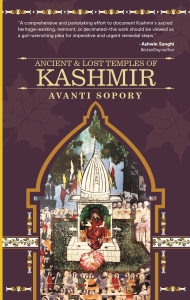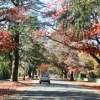
PREFACE
As I come back and write more about Kashmir, I must admit that this time my journey has been challenging. The first time when the idea was shared by my publisher, I agreed to it with alacrity. I did not bat an eyelid because it was about my native land. However, after hanging‑up, I realized that this work will come with a huge responsibility. Kashmir has two meanings for the larger world. There is a part of the valley which is bestowed with rivers, lakes, snowy mountains, springs, meadows, wealthy forests, primeval monuments, salubrious weather, ancient shrines, opulent gardens, and much more. And then there is the other side of the valley which is mystical, unknown, metaphysical, enigmatic, spiritual, and magical. In the myriad centuries and generations, the above physical and spiritual aspect of Kashmir has become a quintessential characteristic of all Kashmiris. Akin to the weaving of Kashmiri carpets and shawls, every Kashmiri is a representation of the material and non-material stories that have percolated since times immemorial. There is a story in every nook and cranny of Kashmir. But no two stories are the same. A story that may sound familiar, but has a different perspective—like the moon which stays the same but people have a diverse frame of reference to it. Ancient and lost temples are the treasured entity of the valley. Writing on the temples was challenging not because I didn’t have enough information, but there were multiple sources to handle with care. Accessing, interviewing, visiting, collating, re-checking, mapping, and taking a 360- degree overview was not easy. There is no doubt that each work I have referred to, whether from ancient, medieval, pre-independence, post-independence, or modern times, has been a work of craftsmanship, kindred like the pieces of art from Kashmir.
This book reflects on the physical and spiritual past of the ancient and lost temples of Kashmir. It also attempts to showcase the architectural marvel that these temples have remained in the past. For the ease and hand-holding of the reader, this book has a unique treatment. I have introduced a fictional character Kabir, who as a research student visits these ruined temples and then collects the factual information about each temple. Kabir is the facilitator, who brings forth the fact-based truth about each of the temples he visits. I am sure the readers will enjoy this novel treatment.
The geographical location of Kashmir has always been at a strategic point. It shares borders with many countries. It was at the summit point, where the oldest and most prodigious civilizations would traverse for trade, cultural exchange, religion, war, conquest, and other such human interactions. The valley of Kashmir has remained a mature location for different religions to flourish. King Kanishka (2nd century bc) from the Kushan dynasty lent his majestic patronage to strengthen the splitting and conflicting interpretation of the basic teachings of Buddha, and because of his dynamic support and devotion, King Kanishka nurtured it throughout the length and breadth of his huge empire, of which Kashmir was a part. It is important to mention that around 70 ad, Kanishka chose Kundalavanavihara, near Harwan, about 19 km from Srinagar city, for holding the monumental religious deliberation. The Council hosted Buddhist and Hindu luminaries and produced about 3,00,000 verses on religious philosophies. Chinese traveller Hiuen Tsang has mentioned about this mega event in his writings. Under the patronage of Kanishka, Vasumitra, Asvaghosa, the council produced the commentaries known as Vibhasha, on Buddhist Tripitaka. The eldest son of Guru Nanakji, Baba Sri Chand, also the founder of the Udasi sect, was once meditating next to the holy dhuni in Kashmir, in the 15th century. Nawab Yakub Khan, from the ruling government, accused Baba Sri Chand of instigating conflict between Hindus and Muslims. Baba immediately whacked a burning stick on the ground. No sooner he stuck the stick on the ground than the flames vanished and the stick sprouted leaves of a beautiful Chinar tree. At that moment, Baba Sri Chand said that God’s tree is broad enough to give shade to everyone. What is amazing is that this Chinar tree still stands there as a monument of peace next to Shakti Sweets, at Residency Road, Srinagar city.
These exchanges led to social, physical, cultural, and religious impacts on Kashmir. Temples and shrines of Kashmir have a unique indigenous design to their structure and aesthetics. Across provinces, the temple structure broadly consisted of a garbhagriha, shikhara, mandapa, or vimana type. The other distinguishing feature was that the base of these buildings was either square or oblong, and was largely constructed out of the same material from the base to the summit. In the case of Kashmir, it was usually grey limestone. Intricate stone carvings, designs, motifs, floral patterns, and sculptures of various Gods and Goddesses are common features across Kashmiri temples. Nags or natural water springs need special mention here. The valley abounds in glaciers, lakes, rivers, streams, and springs. There are numerous springs in the valley, and almost each spring has an associated Shiva temple in physical proximity to it, which is highly regarded by Hindus. These springs have existed since pre-historic times in the valley and command enormous reverence from the locals.
The word ‘Nags’, used multiple times in the book, should not be confused with serpents. The Sanskrit meaning of nag is serpent or snake. But it has a different etymology in Kashmir. The aborigines of Kashmir were a group of people called the Nagas. These people were serpent worshipers and usually dwelled near a spring or water body. According to Nilamata Purana, an ancient text dated around 6th century, which later became the base text for Rajatarangini written by Kalhana in the 12th century, mentions that the N agas (aborigines of Kashmir) revered these water bodies, and the serpent deities living inside them. This brought forth the practice of naga worship or snake cult. The ancient text mentions that great importance was given to these nags (springs) by the aborigines. The four dikpalas (guardians of the four directions)—Bindusara in the east, Elapatra in the west, Uttaramanas in the north, and Srimadaka in the south—were Nagas.
According to Hindu cosmology, the temple is a representation of various symbols. The purpose of the temple is to serve as a superstructure, which is hence designed in such a way that right from the broad base all the lines, joints, etc. converge at one single point—a summit.
These are aesthetically represented through the meru, garbha, kailasha, mandapa, etc. in the temple structure. Hence in the mystical format, the design of a temple takes the shape of a human form, which in theoretical parlance is called Vastupurusha. Starting from the lowermost moulding, which is the feet, the wings of the temple are the arms, the walls are the legs, the platform above is the shoulder and the door of the temple is the mouth. Hence, the temple is purusha and it was conceived and constructed by the means of prakriti, which is the energy represented as feminine power.
Vastupurusha is void without a resident soul. Therefore the image or the pratima of a deity gives life to Vastupurusha. This image is placed in the garbha-griha, where the atma (soul) of the temple resides. The building of temples was a sacred ritual and each building material was consecrated to God.
Besides the spiritual blessings, temples were a greatvenue for social and cultural events. During ancient times, temples would host melas (fairs) to celebrate festivals and auspicious days, therefore they became a great platform for all Kashmiris to interact, feast, and merry-make. According to Nilamata Purana, the Kashmiri society was aesthetic, liberal and free. Women enjoyed unrestricted freedom in Kashmir. Kashmiris celebrated numerous festivals, they liked singing and dancing, they visited gardens where men and women adorned one another with beautiful flowers, presented gifts to each other, played water sports, watched theatre, enjoyed the full-moon night, and listened to stories from the Puranas. They worshipped their Gods ardently and simultaneously pleased the demons.
Everything in Kashmir started with gratitude to the Gods. Even when the ancient city of Pravarapura (today’s Srinagar) was designed by King Sri Pravarasena, in the 5th century ce, he commissioned the building of eight Bhairavnath temples at the eight entry points to the city. Bhairav is another form of Shiva that protects his devotees from fear, anger, and dreadful enemies. These eight points are still popular as the Ashtha Bhairav temples. There is no count for the number of holy caves, springs, shrines, temples, trees, rivers, and mountains, in the valley of Kashmir. Every grain of earth is pious on this land.
Covering all these revered places in a single book would have been an unjustified endeavour. Hence, my effort in this book has been to bring out a condensed focus on temples that are not only ancient but are in oblivion. These religious places have been a testimony to the historical richness and cultural abundance of Kashmir. During my research, I came across antique and valuable texts; it is difficult to give an exact meaning to them. Therefore, I have tried to bring forth the best possible significance of these words and phrases.
My heart wrenches when I see the current state of these historical symbols of Kashmiri identity. These important shrines and religious sanctuaries were built by rulers in ancient times but unfortunately are in a dilapidated condition now. The temples mentioned don’t just reflect the religious sentiments of the natives who had lived in the valley till about the 20th century, but they are a standing testimony to the architecture, dynasty, cultural depth, belief systems, understanding of customs, kingdoms, and royal descent of those times. Audacious enough, even the historic names of some of the ancient sites have been changed. Martand Temple is locally referred to as Shaitan Guffa, Haeri Parbat is also referred to as Koh-re-Maran, Anantnag is called Islamabad, Parihaspura Temples are called Kaen Shaher, to name a few. Some of the temple lands have got encroached on and sold in absentia by the ad-hoc head priest (not belonging to the valley) of the temple. The entire topography has been changed to suit the purpose of the existing majority.
Pravarsena II had built a five-domed brick temple in Srinagar city, which was next to the Zaina Kadal (bridge). The temple is enclosed on three sides by a stone wall and its trefoil arches are adorned with sculptured Hindu divinities. On this spot, there is a sacred spring of Kali.
This spring is in the vicinity of the Shah-i-Hamdan. The Hindu temple which was built over it by Pravarsena was called Kali-Shri. The point where it is located is still called Kalashpura, a corruption of Kali-Shri-Pur. On the wall in front of the river, the Hindus have put red ochre and worship Goddess Kali.
Across the ghat, near the Pathar Masjid is the shrine of Jyeshtha Bhairav and in the west of the masjid is the shrine of Vishakena Bhairav, but both are now within the limits of a graveyard.
The entire temple complex has witnessed many changes. It was converted into a graveyard and Zain-ul-Abidin’s (also popular amongst Kashmiris as Bud-Shah, meaning the big king) mother’s tomb is located inside. Later, the temple was destroyed by Sultan Qutb-ud-Din (12th century Delhi Sultanate) who had built a Khanaqah (building constructed for the conglomeration of Muslim brotherhood) with that material. Even this was burnt twice but was rebuilt later.
In 1819, after the conquest of Kashmir by the Sikhs, their Governor Sardar Hari Singh ordered the demolition of the mosque citing that it was a Hindu temple. He ordered the Muslims to give up their possession. Military officer Phula Singh geared up his arms and aimed towards Pathar Masjid Ghat. Everything was ready to blow up the structure, but at the last moment, Muslims pleaded to Pandit Birbal Dhar (Kashmiri leader who was instrumental in resisting the Afghan rule with the help of Sikh rulers) and requested him to save the mosque. Pandit Birbal Dhar, with an empathetic heart, went to Sardar Hari Singh and told him that the Hindu shrine, though in the keeping of the Muslims was in the most protected condition. Destroying the mosque would only spread hatred and vengeance. Post this, Sardar Hari Singh stopped all orders of any sort of demolishment. Rather than preserving and upkeeping the place, these treasures of the past have been left to oblivion. There are many errs that have happened and despite the degrading condition of these monuments, no official authority is taking the restoration work seriously. Different grants, commissions, and budgets were allocated but there is no concrete action on the ground yet. The agencies continue to pass the buck and play the blame game. A few that I came across during my research are listed below:
– Many structures are under no preservation or administration of any authority.
– There is no serious and focused research work on any ancient temple.
– The text on the ASI (Archeological Survey of India) board pitched at some monuments is not clear.
– At some of the locations, the commentary given by the tour guide is grossly incorrect.
– The indispensable boundary wall at many of the monuments is missing.
– The mine of artefacts, which was ruthlessly defaced and vandalized by the invading Turks, Afghans, and Mongols, has never been restored. They still lay at the point they were hurled at by the attackers.
– The laidback attitude and lack of patronage of the ASI has had an un-bearing impact on the treasured past of Kashmir.
After the many centuries of misrule and outrageous behaviour of the Afghans, Turks, Mongols; the Hindu minority got some respite under the governance of the Dogra dynasty. It was in their rein that they brought back the dignity and confidence of the Kashmiri Hindus. It was under the Dogra rule and administration that some of the demolished and wrecked temples of Kashmir valley were restored. Dogra rulers worked tooth and nail to rebuild these temples and bring them back to their lost glory.
Their work and passion can be inspiring enough for the current team of administrators because monuments are erected for the preservation of history and cultural memory of the community. These structures are testimonials of consciousness and sensitiveness towards the distinct identity of a region. Intent and willingness to preserve the lost legacy needs to be initiated. Although in the recent past, talks and initiations for reinstating some of the religious monuments have gained momentum, this spirit has to be maintained and well patronized. Our agencies can take inspiration from the commendable restoration work which is being undertaken at the ancient temples of Cambodia, Greece, Egypt, and many other countries, which have an astounding heritage just like India. After the seventh exodus of Kashmiri Hindus, who once were in majority in the valley; they should be at least entitled to pay obeisance to the deities, who once lived in these temples. As my great-grandfather, Master Samsar Chand Kaul wrote in his book The Holy Spring of Kheer Bhawani, “. . .The kind of close relationship that a body has with the universe, similarly Kashmir has a close relationship with the whole of India. All the pilgrimages of the Hindu religion, all deities, and all the places of pilgrimage, all of them are sub-located in one way or another in Kashmir. Kashmir’s oldest historic book Neelamt-Puraan is the witness of this fact and it is definitely proved by public opinion. . .”
The oval-shaped valley of Kashmir became a favourite amongst scholars, intellectuals, researchers, and seekers of knowledge and wisdom, not only from pan-India but also the neighbouring countries. Whether it is non-dualism Shaivism, the theory of art, Mahayana Buddhism, the enrichment of the Sanskrit language, the idea of aesthetics, the philosophy of language, the notion of erotic, the communicative role of Sharada script, Tantric rituals, works of Adi Guru Shankaracharya, the visit of Swami Vivekananda, enrichment of literary genres, writing of plays or theatre works or stories, and much more; Kashmir’s contribution has been so significant in all these areas, that the history of Indian cultural tradition remains incomplete without taking them into consideration. Kashmir remains to be the fountainhead of the Indian cultural and civilizational matrix.
For the convenience of the reader, I have divided the researched temples into four prominent parts, namely:
1. The ancient temples which are in ruins but some of
their remnants can be traced.
2. The ancient temples which are completely decimated
and lost.
3. The ancient temples which are still existing.
4. The Ashtha Bhairavs.
Aurel Stein, in his translation of Rajatarangini, mentions about Kashmir, “Kashmir is a country where there is not a place as large as a grain of sesame without a Tirtha. Time and conversion to Islam of greater portion of population has changed but little in this respect. This book is therefore a humble attempt at bringing to focus the pre-historical, cultural, civilizational, religious, and intellectual enterprise and contribution of Kashmiri Pandits in the entire subcontinent.”
I would like to conclude with a poem written by the famous Kashmiri poet Motilal ‘Saqi’, in the 1990s. The poem laments at the loss of temples, and their dismal plight.
The original Kashmiri poem is followed by the English translation.
Chhi vony mandori manz baskeen kats taam,
Vadaan vady-vady karaan tim shaam subahas,
Khabar chhakh vuny-na-vuny paeyi sheri lab paeth
Khabar chhakh asy chhi be-dasgaah, karan kyaah,
Karaan shets kaen chhu yeth mandori vusavaar,
Yi bachaeyi vaaensan ta deva doh saaeny naeran,
Achhin tal raazabal chhukh aes vaeharith.
A few dwellers still remain in the temple
They cry, their mornings turn to night
Crying.
They know any moment now,
Bricks will bury them all.
They know they are friendless,
There is nothing to be done
They console themselves:
The bricks of the old temple are still strong.
It may yet survive,
Just long enough
For us to live out our sad lives
The burning pyres stare them in the eye
With its mouth ever open.
(Poem taken from the blog ‘searchkashmir’)
About the Author







Comments